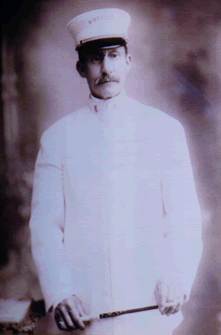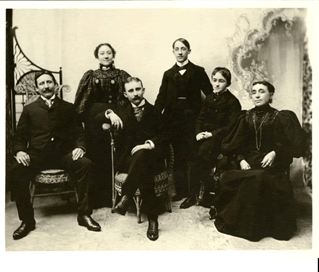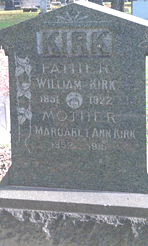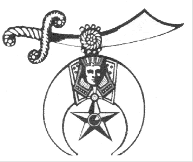William Kirk 1851 - 1922
Margaret Kirk 1852 - 1915
Hey Leader, Strike up the Band
William Kirk was born September 27, 1851, in Edinburgh, Scotland. His mother, Jane, was a staymaker; his father, John, a soldier and later a tailor. William became a bandsman in the British Army, specifically the 93rd Sutherland Highlanders, served in India, and later was stationed at Aberdeen and Edinburgh Castle. He married Margaret Ann Beatten, a dressmaker, at St. Andrew’s Chapel, S. B. Canongate, Edinburgh, on his 21st birthday in 1872. Margaret was born in August of 1852, the daughter of John Beatten, farm laborer, and Jane Stuart. William left the Army and came to Cleveland with Margaret in 1873 or 1874.

Sometime after arrival in the U.S. William was with Dan Rice’s circus. Dan Rice (1823 – 1900), born Daniel McLaren, gained 19th century fame with many talents including his performances as a clown. Rice changed the circus into what it is today by mixing animals, acrobats and clowns. He went into producing his own shows which became more famous than any of the other shows touring at the time including those of Phineas Taylor Barnum. Rice’s name was synonymous with theater which he reinvented into a vaudevillian style before there was a vaudeville.
Kirk’s experience with Dan Rice no doubt influenced the young man’s approach to his career. He eventually took over the Oriental Cornet Band, changing its name to the Knights of Pythias Band and made the men keep their feet off the chairs and stop chewing and smoking tobacco while they were playing. The name of the band was later changed to Kirk’s Military and Concert Band.
Howard Beaufait of the Cleveland News, said Kirk’s band became “the finest in this section of the country, giving park concerts, playing for dances, and adding musical ceremony to the four or five race tracks around the county at that time.” Kirk’s band led the procession over the Superior Viaduct when it was completed in 1878 and was the last band to cross it when it was torn down. The band played at the opening of Euclid Beach Park on June 30, 1895, and at the opening of the Detroit-Superior High Level Bridge in 1914. His 40-man band played from September 2-8, 1901, at the Pan American Exposition in Buffalo, New York.
In March of 1905 Kirk’s band was traveling to Washington for the inauguration of President Theodore Roosevelt. They were accompanying the Third Battalion of Engineers of the Ohio National Guard and intended to lead the engineers in a parade in Washington. The engineers and Kirk’s band had loaded into six Pullman cars around 2:00PM in Cleveland. Kirk’s band members occupied the first Pullman behind the engine while cars 2-5 housed engineers from various companies of the battalion and car 6 housed the officers of the battalion. The train experienced some technical problems and had to stop twice to make repairs. While stopped the second time around 7:00PM, eight miles from Pittsburgh, another train behind them loaded with members of the Tippecanoe Club was unable to stop for whatever reason and collided with the engineers’ train. Car #6 was severely damaged, bursting into flames almost immediately. Nine men died and many more were badly injured. The train carrying the Tippecanoe Club members also caught fire and the engine and two cars went up in flames. Some members of the Club were injured but there were no fatalities. William Kirk and his band sustained no injuries except for the trauma of being involved in the accident. Kirk’s band and those engineers who were not injured returned to Cleveland the next day.
William’s sons James and John played in their father’s band for a number of years. John later formed John Kirk’s Orchestra. Among other venues, John’s orchestra played at Euclid Beach Park, Edgewater Park and Gordon Park and on a boat called the Eastland, which carried passengers between Cleveland and Cedar Point.
William and Margaret had five children – John Beatten, born 1874, William Andrew, born 1876, Margaret Ann, born 1879, James Paul, born 1884, and Hugh Arthur, born 1888. Hugh died in 1889 of croup. James died in 1908 of cerebral spinal meningitis. Both Hugh and James are buried in Monroe Street Cemetery. Daughter Margaret Ann married Julius Bruehler who died in 1924. She died in 1963 and was buried in Monroe Street Cemetery. William Andrew lived until 1956.

William’s wife Margaret died November 30, 1915, of pneumonia and was buried in Monroe Street Cemetery. After his wife’s death, William married Isabella Finley, 36 years his junior. William died April 18, 1922 of cholelithiasis, a gallbladder condition caused by formation of gallstones. William is buried next to his first wife, Margaret.

The emblem found on William Kirk’s headstone indicates that he was a Mason and a member of the Mystic Shrine. The official emblem of the Mystic Shrine is the Crescent . It is composed of two Royal Bengal Tiger Claws united in a gold setting by a Keystone. Inside the Keystone – on the Keystone’s face – is the head of a Sphinx. Originally behind the crescent were a pyramid, urn, and star. Below the crescent, hangs the Star of Bethlehem. Depicted above the crescent is a Scimitar from which the crescent and Star are suspended. The Star of Bethlehem is a clear reference to the “Star in the East” observed at the time of the birth of Jesus Christ.

This emblem came in many forms as Shrines around the country developed their own unique logo. The basic elements were always used but the designs varied. The emblem on William Kirk’s headstone has weathered badly and is somewhat indistinct however a close look at it seems to show it similar to a variant of the Scimitar & Crescent used by the Midian Shrine in Wichita, Kansas as shown above. The coiled rope at the center of the scimitar represents a Cable-Tow, an image that every Mason is familiar with. The significance of the coil is the “Mystic Tie” of brotherhood – the Cable-Tow which binds and guides Masons and governs their sense of duty to themselves and their fellow man.
The “Gay 90’s”, as the period from 1891 to 1900 came to be called, was a decade of great festivals and great depression. The 1893 Columbian Exposition in Chicago, known as the “White City”, brought people from all over the world to delight in the architectural, industrial, agricultural, scientific and economic accomplishments of America. In 1896 the citizens of the city of Cleveland memorialized the founding of their great city through weeks of centennial celebrations. The “high life” of the old-money families was well-documented by the press and America’s involvement in South America and the Caribbean was a precursor to America’s dominant position in the global economy.

In reality, the US economy was not enduring a tangible amount of prosperity for most of the decade. The beginning of the decade saw an economic crisis develop due to high tariffs and the introduction of low-valued silver coinage to counter growing inflation. The economic crisis was greatly worsened when the Panic of 1893 set off a widespread economic depression in the United States that lasted until 1896.
Similar to the Panic of 1873, it was marked by the collapse of railroad overbuilding and shaky railroad financing, resulting in a series of bank failures. Compounding market overbuilding and the railroad bubble, was a run on the gold supply. The Panic of '93 was the worst economic depression the United States had ever experienced at the time.